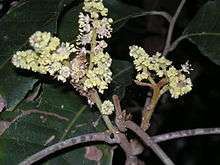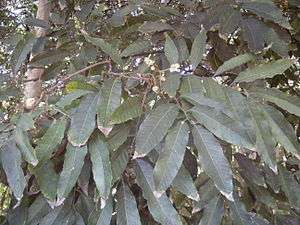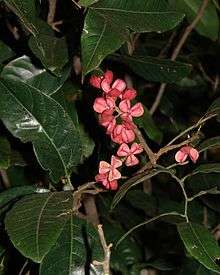Elattostachys microcarpa
Elattostachys microcarpa, commonly named scrub tamarind, is a species of rainforest trees of north-eastern Australia. They grow naturally in the relatively seasonal rainforests, which may have a drought season and often in association with Kauri pine.[1]
| Scrub tamarind | |
|---|---|
 | |
| Flowering | |
| Scientific classification | |
| Kingdom: | Plantae |
| Clade: | Tracheophytes |
| Clade: | Angiosperms |
| Clade: | Eudicots |
| Clade: | Rosids |
| Order: | Sapindales |
| Family: | Sapindaceae |
| Genus: | Elattostachys |
| Species: | E. microcarpa |
| Binomial name | |
| Elattostachys microcarpa | |
The name Elattostachys refers to "little spikes", a flower feature of other plants in this genus. The specific name microcarpa refers to the small woody seeds.
Description
A tree up to 15 metres (50 ft) tall, with a stem diameter of up to 30 cm (12 in). Leaves pinnate and arranged alternately on the stem. Leaflet blades approximately 100×30 mm (3.9×1.2 in). Young shoots and terminal buds covered with short pale hairs.[1]
Cream flowers form on panicle, followed by round pink or red fruit which split to reveal black glossy seeds


References
- Hyland, B. P. M.; Whiffin, T.; Zich, F. A.; et al. (Dec 2010). "Factsheet – Elattostachys microcarpa". Australian Tropical Rainforest Plants (6.1, online version RFK 6.1 ed.). Cairns, Australia: Commonwealth Scientific and Industrial Research Organisation (CSIRO), through its Division of Plant Industry; the Centre for Australian National Biodiversity Research; the Australian Tropical Herbarium, James Cook University. Retrieved 12 May 2013.